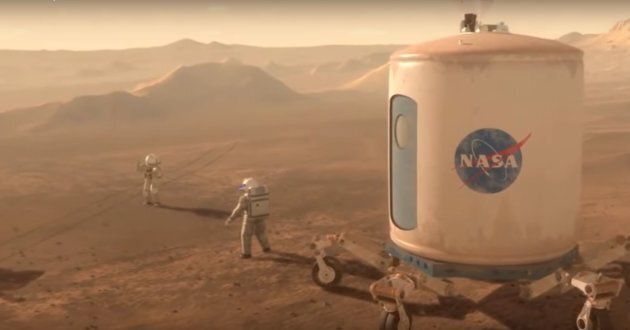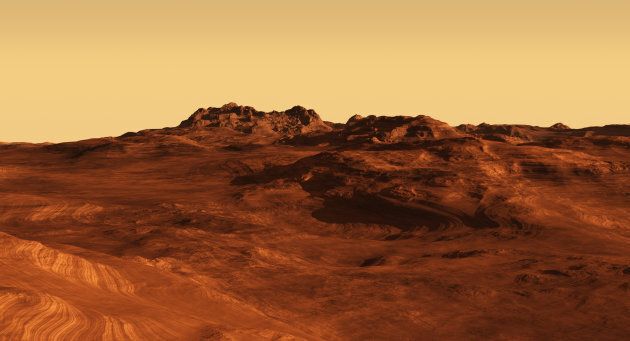Matt Damon's stint on Mars in the film 'The Martian' was futuristic and compelling, but when it comes to how humans could actually inhabit the red planet, NASA has vastly different ideas.
NASA's plan to send astronauts on a one-way mission to Mars in the 2030s and 40s is in the works. The idea behind this is to build a colony on our neighbouring planet, that will be a self-sustaining society in the future, just like the one here on Earth.
The first person to suggest this mission to Mars was professor Paul Davies. He believes that a one-way mission will keep costs down (80 percent of the cost, by his estimates, is coming back) and will provide humanity with a real chance to populate the universe.

"I suggested that idea in 2003 and most people misunderstood, they thought that it was a suicide mission," Davies said at the 'Life On Mars: The 2020 Rover Mission' talk at the Sydney Opera House.
"A one-way mission doesn't mean you get three weeks on the surface of Mars and that's it. The whole idea is to establish a permanent human presence on the red planet so the first astronauts to go will be like the trail blazers and they would set out base camp."
But getting to Mars is no easy feat. Not only does NASA need to send the humans, but also everything they need to establish a self-sustaining colony.
This includes everything from food, to energy-making resources, water and even oxygen. The actual colony is designed to eventually be self-sufficent, even if this does take a few centuries, and is expected to eventually have internet connection, so the martians won't feel like they are worlds away.
Here's what it will look like.
"You want to launch when Earth and Mars are close together, so it takes less time and less energy to get there," NASA's Dr Mitchell Schulte said at the talk.
"And if you are going to send humans, then you need to send everything they need to survive with them. It takes our rovers about seven to eight months to get there... but sending people, because we have to send so much material and so much mass, it's going to take a year and a half [to] two years just to get there and the same amount of time to get back."
Before this can happen however, NASA has one important mission planned. This is the Mars 2020 Rover Mission, which aims to conduct all kinds of research about the red planet, including trying to determine how ancient forms of life started there.

If life did in fact exist on Mars, it would have been billions of years ago and it most probably would have existed in microbial form. It is this specifically that the next NASA mission to Mars in 2020 aims to find out.
"What we are focusing on this time, for this mission, is looking for signs of life on the surface of Mars. Past, ancient life that might have existed in really ancient terrains on the surface of Mars," Schulte said.
Schulte, as NASA's Mars 2020 Rover Mission's program scientist, explained how the upcoming mission is going to try and find signs of life.
A major part of NASA's strategy is sending a rover, very similar to the Curiosity rover -- which was launched back in 2011 -- however, this one will be decked out with high-tech equipment and will be able to take samples from the red planet and bring them back to Earth for study.
"We have a number of instruments and... these instruments are all designed to look at the scale that we think life existed on Mars, which is the micro-scale," Schulte explained.
"Most of the biomass... is microbial. That's stuff that you can't see with the naked eye, so we really need to get down to that level on the surface of Mars when we are looking for evidence of life in Mars' past.
"So all of these instruments are designed to go from large scales kinds of structures all the way down to the micro-scale."
One of these instruments was designed by geologist Dr Abigail Allwood, who is the first woman and the first Australian to be appointed as one the principle investigators for the 2020 Mission. Allwood designed the Planetary Instrument for X-ray Lithochemistry (PIXL) that will sit on the arm of the Mars rover.
PIXL uses tiny x-rays, the width of a human hair, to detect energy and chemical elements that could be present in rocks. This will help scientists work out if and when life existed on Mars.
"We end up being able to... study the chemistry of the rocks at very, very fine sub-millimetre scales and we move that tiny [X-ray] beam around and... we build up a postage stamp-sized map of the chemistry of the rocks and we can correlate that with the very fine scale textures that you see," Allwood said at the talk.
So while a self-sustaining human colony on Mars seems as unbelievable as Matt Damon actually being able to live there, NASA is planning seriously for a time when real people will live on the red planet.
The people that actually go, while there are risks surrounding life expectancy and radiation, will be the pioneers for the next generation of humanity and will lay the foundation for humans to start populating the galaxy. If all goes to plan, people will be moving to Mars permanently in the next 50 years.
Would you volunteer?
